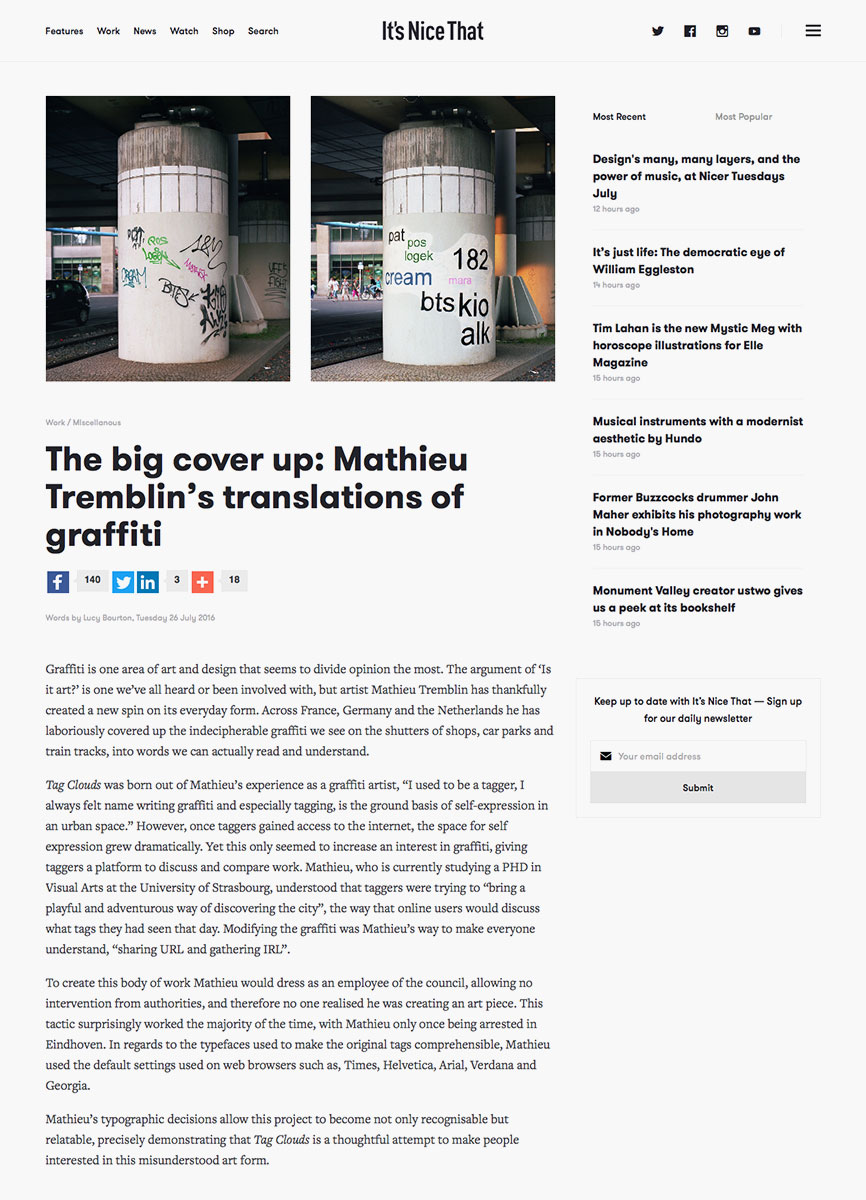“The big cover up: Mathieu Tremblin’s translations of graffiti”, Lucy Bourton, It’s nice that, www.itsnicethat.com, 26th July 2016.
[EN]
Lucy Bourton: How did this project come about?
Mathieu Tremblin: As I used to be a tagger, I always felt name writing graffiti and especially tagging is nowadays the ground basis of self-expression in urban space, in the frame of globalization, because this form appears to be a simple and spontaneous answer to absolute capitalism (Jacques Rancière) which is turning democratic space into consumerism space, reducing individual expression of the citizens to a matter of choices between brands.
From around 2000 when I started graffiti to 2006 when I started to make independent interventions under the pseudonym of Les Frères Ripoulain with my colleague David Renault, the community of writers that used to share their works with fanzine went online, using Fotolog as a platform for sharing URL and gathering IRL. Then with the raise of social networks a part of name writing graffiti started to be discovered through images on a computer screen, and not through direct experience while travelling to the city it was happening.
At some point, I just connected the way tagging could bring a playful and adventurous way of discovering the city and the manner that tag clouds were creating cross over paths during our daily journey on the Internet. Tag Clouds seems to be a good way to create bridges between two sides of experiencing name writing and a proper manner to pay respect to local writers by doing a mural, instead of playing the classical graffiti game which would be to cover up a hall of fame with a bigger decorative fresco with only one stylized name (as most of the writers are doing it).
LB: Did you receive any negative comments about what you were doing?
MT: I never had any negative comment in real life as I’m doing this intervention mostly without autorisation, dressed like a city worker in order people or police do not realize I’m creating an art piece. I also didn’t get any wrong feedback of writers involved since now because I’m playing the getting up game of graffiti, not working with municipality as my intent is not to make the city cleaner but to promote name writing. I have been arrested once in Eindhoven for doing it, because Eindhoven has a zero tolerance policy for any kind of uncommissionned form of art in the city, especially the ones that are close to graffiti.
I get negative comments mostly on Internet, especially on blogs which are showing the documentation as it was the work itself, without bringing context to it (in every day life, there’s not possibility of comparing before/after intervention, name writing graffiti disappears and is repaved by Tag Clouds). I get negative comments from writers who have a conservative conception of name writing graffiti and a lack of understandment of the intervention: writers who think common people shouldn’t even get in touch with the hidden agenda of writing.
I get negative comments from people who hate graffiti and refuse I could bring any positive/different perspective on the subject, even just make people interested into it.
But I think Tag Clouds is actually addressing the public aspect of urban space in paradoxical way, which makes it relevant. This intervention is bringing the debate of private property (the one of the writers and the one of the owners of the wall) versus public space and common interest.
LB: Did you make particular decisions about the typefaces used to cover up the previous graffiti?
MT: As the principle is to switch from a cryptic analog langage to a digital coded one,
the choice of the typefaces is based on a default aesthetic (Étienne Cliquet), the one that web browsers were using to display webpages and tag clouds especially when I started this intervention. Typefaces installed by default on each computer: Times, Helvetica, Arial, Verdana, Georgia…
LB: Can you tell us more in this connecting between physical tagging and and virtual tagging?
MT: As I explain it in my intent:
It shows the analogy between the physical tag and the virtual tag, both in form (tagged wall compositions look the same as tag clouds), and in substance (like keywords which are markers of net surfing, graffiti are markers of urban drifting).
Complete interview by Lucy Bourton, July 2016.
Tags: interview, publication


